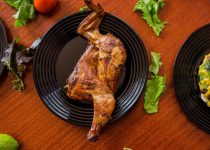How to Cook Beef Rump Roast on Rotisserie
Imagine the savory aroma of perfectly seasoned beef rump roast slowly rotating on a rotisserie, creating a mouthwatering crust while locking in its natural juices.
Cooking a beef rump roast on a rotisserie can seem like a daunting task, but with the right techniques, it can be a rewarding and delicious experience.
From selecting the ideal cut of meat to mastering the art of trussing, this method promises to deliver a tender and flavorful roast that will have your guests coming back for more.
So, if you're ready to elevate your culinary skills and impress your dinner guests with a succulent beef rump roast, let's get started.
Selecting the Perfect Beef Rump Roast
When selecting the perfect beef rump roast, look for a cut that's well-marbled and has a bright, red color for the best flavor and tenderness when cooked. Marbling refers to the thin streaks of fat running through the meat, which enhances the flavor and juiciness. Look for beef cuts with a good amount of marbling as this indicates a higher quality roast. The marbling will melt during cooking, infusing the meat with rich, savory flavors and keeping it moist.
Consider your cooking methods and doneness preferences when choosing the size and shape of the beef rump roast. If you prefer your roast on the rare side, opt for a thicker cut that can withstand the longer cooking time without drying out. Conversely, if you prefer a well-done roast, a thinner cut will cook through more evenly. Select a rump roast that suits your rotisserie or cooking equipment, ensuring it will cook evenly and to your desired level of doneness.
When you've found the perfect beef rump roast, the marbling and cut will work together to create a flavorful and succulent dish that will impress your guests.
Preparing the Rotisserie and Seasoning the Roast
To prepare the rotisserie for cooking the beef rump roast, ensure that it's clean and properly set up according to the manufacturer's instructions. Here's what you need to do:
- Rotisserie Maintenance: Before using the rotisserie, ensure that all parts are clean and in good working condition. Check for any signs of wear or damage, and make sure the spit rod and forks are securely attached.
- Seasoning Tips: Coat the beef rump roast with your favorite seasoning blend. A simple mix of salt, pepper, garlic powder, and paprika can work wonders. Make sure to massage the seasoning into the meat for even flavor distribution.
- Rotisserie Safety: Always prioritize safety when using the rotisserie. Double-check that the roast is securely fastened to the spit rod and that the rotisserie is stable and balanced before starting the cooking process.
- Cooking Time Estimation: As a general rule, beef rump roast typically takes about 20-25 minutes per pound to cook on a rotisserie. However, it's essential to use a meat thermometer to ensure the roast reaches an internal temperature of at least 145°F (63°C) for medium-rare or your desired level of doneness.
Trussing the Roast for Even Cooking
After ensuring that your rotisserie is clean and properly set up, the next step is to truss the beef rump roast for even cooking. Trussing involves tying the roast with kitchen twine to ensure it maintains a uniform shape during the cooking process. This technique promotes even cooking and flavor infusion, resulting in a juicy and tender roast. Below are some trussing techniques and cooking methods to help you achieve the perfect beef rump roast on the rotisserie.
| Trussing Techniques | Cooking Methods |
|---|---|
| Tying the roast at 2-inch intervals helps it cook evenly. | Using indirect heat on the rotisserie prevents the exterior from burning while ensuring the interior cooks thoroughly. |
| Trussing the roast tightly helps it retain its shape, ensuring uniform cooking. | Basting the roast with marinade or juices during the rotisserie process enhances flavor infusion and juiciness. |
| Securing the twine firmly keeps the roast compact, resulting in a uniform and appealing final product. | Allowing the roast to rest for a few minutes after cooking helps redistribute the juices, ensuring a moist and succulent roast. |
Setting Up the Rotisserie and Cooking the Roast
Once you have trussed the beef rump roast, proceed to set up the rotisserie and prepare for the cooking process.
To set up the rotisserie and cook the roast, follow these steps:
- Rotisserie Maintenance: Before use, ensure the rotisserie is clean and in good working condition. Check for any loose parts or signs of wear to prevent accidents during cooking.
- Safety First: Always place the rotisserie in a stable and fire-safe location. Keep it away from flammable materials and make sure it's properly secured before turning it on.
- Prepare the Roast: Season the beef rump roast with your favorite rub or marinade. Ensure it's secured firmly on the rotisserie spit, balanced for even cooking.
- Rotisserie Cooking Tips: Start the rotisserie on low heat, gradually increasing the temperature. Avoid excessive heat, as slow cooking will result in a juicier and more flavorful roast.
- Tricks for Success: Use a drip pan beneath the roast to catch the flavorful drippings. Baste the roast occasionally to keep it moist and add layers of flavor.
Checking the Internal Temperature and Resting the Roast
Now it's time to make sure your beef rump roast is cooked perfectly. Use a meat thermometer to check the internal temperature of the roast to ensure it's done to your liking.
After it's reached the desired temperature, let the roast rest for a few minutes to lock in the juices and ensure a tender, flavorful result.
Internal Temperature Check
For a perfectly cooked beef rump roast on the rotisserie, it's crucial to ensure the internal temperature is just right before serving and allowing the roast to rest. Here's how to check the internal temperature and ensure your roast is cooked to perfection:
- Temperature Accuracy: Ensure your meat thermometer is accurate and calibrated for precise readings.
- Meat Thermometer: Invest in a reliable meat thermometer to accurately gauge the internal temperature of the roast.
- Insert Thermometer: Insert the meat thermometer into the thickest part of the roast, avoiding contact with bones for an accurate reading.
- Ideal Temperature: Aim for an internal temperature of 135°F for medium-rare, 145°F for medium, and 160°F for well-done.
- Resting the Roast: After reaching the desired temperature, let the roast rest for 15-20 minutes before carving to allow the juices to redistribute, resulting in a juicy and flavorful roast.
Resting for Juiciness
To ensure a juicy and flavorful beef rump roast, it's essential to check the internal temperature and allow the roast to rest before carving. Once the roast reaches the desired temperature, typically 135°F (57°C) for medium-rare, carefully remove it from the rotisserie and place it on a cutting board.
Loosely tent the roast with aluminum foil and let it rest for about 15-20 minutes. This resting period allows the juices, which have been forced towards the exterior during cooking, to redistribute throughout the roast. As a result, the roast will be more tender and succulent when carved.
During this time, the internal temperature may also rise a few degrees, contributing to the perfect doneness and ensuring a delectable dining experience. These resting techniques are crucial for achieving optimal meat tenderness.
Carving and Serving the Juicy Beef Rump Roast
Carve the juicy beef rump roast into thin, tender slices, ensuring each serving is full of flavor and tenderness. Here are some tips to help you present and serve the mouthwatering roast:
- Carving Techniques: Position the roast on a cutting board and use a sharp carving knife to slice it against the grain for maximum tenderness. Angle the knife to achieve thin slices, and be sure to remove any excess fat as you carve.
- Presentation: Arrange the slices on a serving platter, overlapping them slightly to showcase the juicy texture and rich color of the meat. Garnish with fresh herbs or a sprinkle of cracked black pepper for an elegant touch.
- Serving Suggestions: Pair the beef rump roast with creamy mashed potatoes, roasted vegetables, or a crisp garden salad to create a well-rounded meal that complements the robust flavor of the roast.
- Accompaniments: Consider offering a side of savory gravy or a tangy horseradish sauce to enhance the roast's taste and provide additional depth of flavor.
- Enjoy: Invite your guests to savor the succulent roast, and encourage them to customize their plates with the delicious accompaniments and sides. Bon appétit!
Frequently Asked Questions
Can I Use a Different Type of Meat for This Rotisserie Recipe, or Does It Have to Be Beef Rump Roast?
You can definitely use different types of meat for the rotisserie recipe. Experiment with chicken, pork, or lamb, adjusting cooking times as needed. The rotisserie method is versatile and can yield delicious results with a variety of meats.
Is It Possible to Use a Different Cooking Method, Such as Grilling or Oven Roasting, for the Beef Rump Roast Instead of Using a Rotisserie?
You can definitely explore other cooking methods for your beef rump roast. For a grilling alternative, sear the roast over direct heat, then finish over indirect heat. For an oven roasting method, cook the roast at a low temperature until it reaches your desired doneness.
How Can I Adjust the Cooking Time and Temperature if I Have a Larger or Smaller Beef Rump Roast Than the One Specified in the Article?
When adjusting the size of your beef rump roast, simply modify the cooking time and temperature accordingly. Larger cuts may require lower temperatures and longer cooking times, while smaller cuts might need higher temperatures and shorter cook times.
What Are Some Recommended Side Dishes or Sauces to Serve With the Beef Rump Roast?
For side dish options, consider roasted vegetables, garlic mashed potatoes, or a fresh salad. As for sauce pairings, try a red wine reduction, creamy horseradish, or a classic au jus. These pairings will complement the rich flavors of the beef rump roast.
Are There Any Tips for Storing and Reheating Leftover Beef Rump Roast?
When storing leftover beef rump roast, place it in an airtight container in the fridge for up to 3-4 days. To reheat, use the oven or microwave for best results. Add a splash of beef broth to keep it moist. Enjoy!



